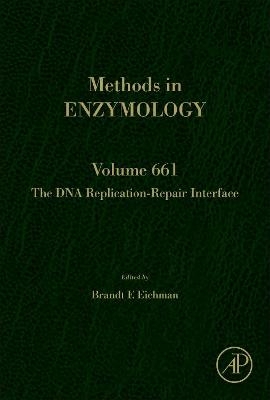
The DNA Replication-Repair Interface
Academic Press Inc (Verlag)
978-0-323-90733-0 (ISBN)
Other chapters explore MIDAS: Direct sequencing to map mitotic DNA synthesis and common fragile sites at high precision, Studying the DNA damage response in embryonic systems, GLASS-ChIP to map Mre11 cleavage sites in the human genome, New chemical biology approaches to trap reaction intermediates in living cells, Single-molecule imaging approaches for monitoring replication fork conflicts at genomic DNA G4 structures and R-loops in human cells, Monitoring the replication of structured DNA through heritable epigenetic change, Visualizing replication fork encounters with DNA interstrand crosslinks, and much more.
Dr. Eichman is a Professor of Biological Sciences and Biochemistry at Vanderbilt University, where his laboratory investigates the structural mechanisms of protein machines involved in maintenance of genome integrity. Professor Eichman was initially trained as a synthetic organic chemist at the University of Mississippi (B.S., Chemistry, 1993). He received his Ph.D. in Biochemistry and Biophysics in 2000 from Oregon State University, where he used X-ray crystallography to study the effects of crosslinking agents on DNA structure and determined the landmark structure of the Holliday junction, the four-stranded DNA intermediate formed during genetic recombination. As an NIH postdoctoral fellow from 2000-2004 with Tom Ellenberger at Harvard Medical School, Eichman studied the structural enzymology of DNA repair and replication proteins. Current projects in the Eichman lab focus on base excision repair of DNA alkylation damage and restart of stalled replication forks during the DNA damage response. Dr. Eichman holds the 2009 Young Investigator Award from the Sigma Xi Scientific Research Society, the Vanderbilt Chancellor’s Award for Research, two Vanderbilt-Ingram Cancer Center Impact Awards, and in 2013 became a member of the Faculty of 1000. Eichman teaches introductory and advanced undergraduate biochemistry and serves as the co-Director of the Vanderbilt Undergraduate Program in Biochemistry and Chemical Biology.
Preface
1. Eukaryotic DNA replication with purified budding yeast proteins
2. Monitoring the replication of structured DNA through heritable epigenetic change
3. Visualizing replication fork encounters with DNA interstrand crosslinks
4. Single-molecule imaging of replication fork conflicts at genomic DNA G4 structures in human cells
5. Studying the DNA damage response in embryonic systems
6. Analysis of repair of replication-born double-strand breaks by sister chromatid recombination in yeast
7. Determining the kinetics of break-induced replication (BIR) by the assay for monitoring BIR elongation rate (AMBER)
8. Genomic mapping of DNA reaction intermediates in living cells with engineered DNA structure-trap proteins
9. A mapping platform for mitotic crossover by single-cell multi-omics
10. Characterization of DNA-PK-bound end fragments using GLASS-ChIP
11. Light activation and deactivation of Cas9 for DNA repair studies
12. A Detection method for the capture of genomic signatures: from disease diagnosis to genome editing
13. A method to sequence genomic sites of mitotic DNA synthesis in mammalian cells
14. Loop-seq: a high-throughput technique to measure the mesoscale mechanical properties of DNA
15. Characterization of the telomerase modulating activities of yeast DNA helicases
16. Single-molecule studies of yeast Rad51 paralogs
17. Synthesis and polymerase bypass studies of DNA-peptide and DNA-protein conjugates
18. Chemistry and structural screen integrated efficiently for structure-based inhibitors to nucleic acid enzymes targeting the DNA repair-replication interface and SARS CoV-2
| Erscheinungsdatum | 26.11.2021 |
|---|---|
| Reihe/Serie | Methods in Enzymology |
| Verlagsort | Oxford |
| Sprache | englisch |
| Maße | 152 x 229 mm |
| Gewicht | 590 g |
| Themenwelt | Naturwissenschaften ► Biologie ► Biochemie |
| Naturwissenschaften ► Biologie ► Genetik / Molekularbiologie | |
| ISBN-10 | 0-323-90733-4 / 0323907334 |
| ISBN-13 | 978-0-323-90733-0 / 9780323907330 |
| Zustand | Neuware |
| Haben Sie eine Frage zum Produkt? |
aus dem Bereich


